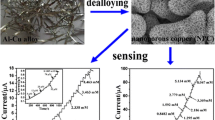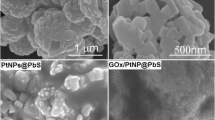Abstract
Alloy nanoparticles of the type PtxFe (where x is 1, 2 or 3) were synthesized by coreduction with sodium borohydride in the presence of carbon acting as a chemical support. The resulting nanocomposites were characterized by scanning electron microscopy and X-ray diffraction. The nanocomposite was placed on a glassy carbon electrode, and electrochemical measurements indicated an excellent catalytic activity for the oxidation of glucose even a near-neutral pH values and at a working voltage as low as 50 mV (vs. SCE). Under optimized conditions, the sensor responds to glucose in the 10.0 μM to 18.9 mM concentration range and with a 3.0 μM detection limit (at an S/N ratio of 3). Interferences by ascorbic acid, uric acid, fructose, acetamidophenol and chloride ions are negligible.

Nonenzymatic sensing of glucose is demonstrated at neutral pH values and low working potential using a glassy carbon electrode modified with platinum-iron alloy nanoparticles on a carbon support.







Similar content being viewed by others
References
Shen PF, Xia YS (2014) Synthesis-modification integration: one-step fabrication of boronic acid functionalized carbon dots for fluorescent blood sugar sensing. Anal Chem 86:5323–5329
Niu XH, Lan MB, Zhao HL, Chen C (2013) Highly sensitive and selective nonenzymatic detection of glucose using three-dimensional porous nickel nanostructures. Anal Chem 85:3561–3569
Wang GF, He XP, Wang LL, Gu AX, Huang Y, Fang B, Geng BY, Zhang XJ (2013) Non-enzymatic electrochemical sensing of glucose. Microchim Acta 180:161–186
Chen XM, Wu GH, Cai ZX, Oyama M, Chen X (2014) Advances in enzyme-free electrochemical sensors for hydrogenperoxide, glucose, and uric acid. Microchim Acta 181:689–705
Wang J (2008) Electrochemical glucose biosensors. Chem Rev 108:814–825
Barone PW, Parker RS, Strano MS (2005) In vivo fluorescence detection ofglucose using a single-walled carbon nanotube optical sensor: design, fluo-rophore properties, advantages, and disadvantages. Anal Chem 77:7556–7562
Waynant RW, Chenault VM (1998) Overview of non-invasive fluid glucose measure-ment using optical techniques to maintain glucose control in diabetes mellitus. LEOS Newsl 3:3–6
Devadoss A, Sudhagar P, Das S, Lee SY, Terashima C, Nakata K, Fujishima A, Choi WB, Kang YS, Paik UY (2014) Synergistic metal-metal oxide nanoparticles supported electrocatalytic graphene for improved photoelectrochemical glucose oxidation. Appl Mater Interfaces 6:4864–4871
Weiss R, Yegorchikov Y, Shusterman A (2007) Noninvasive continuous glucose monitoring using photoacoustic technology-results from the first 62 subjects. Diabetes Technol Ther 9:68–74
Shen XW, Huang CZ, Li YF (2007) Localized surface plasmon resonance sensing detection of glucose in the serum samples of diabetes sufferers based on the redox reaction of chlorauric acid. Talanta 72:1432–1437
Cheng Z, Wang E, Yang X (2001) Capacitive detection of glucose using molecularlyimprinted polymers. Biosens Bioelectron 16:179–185
Guo MM, Wang PS, Zhou CH, Xia Y, Huang W, Li ZL (2014) An ultrasensitive non-enzymatic amperometric glucose sensor based on a Cu-coated nanoporous gold film involving co-mediating. Sensors Actuators B Chem 203:388–395
Mathew M, Sandhyarani N (2013) A highly sensitive electrochemical glucose sensor structuring with nickel hydroxide and enzyme glucose oxidase. Electrochim Acta 108:274–280
Li K, Fan GL, Yang L, Li F (2014) Novel ultrasensitive non-enzymatic glucose sensors based on controlled flower-like CuO hierarchical films. Sensors Actuators B Chem 199:175–182
Vassilyev YB, Khazova OA, Nikolaeva NN (1985) Kinetics and mechanism of glucose electrooxidation on different electrode-catalysts: Part I. Adsorption and oxidation on platinum. J Electroanal Chem 196:105–125
Zhang H, Xu XQ, Yin YJ, Wu P, Cai CX (2013) Nonenzymatic electrochemical detection of glucose based on Pd1Pt3-graphene nanomaterials. J Electroanal Chem 690:19–24
Moghimi NS, Leung KT (2013) FePt alloy nanoparticles for biosensing: enhancement of vitamin C sensor performance and selectivity by nanoalloying. Anal Chem 85:5974–5980
Zhang H, Xu JJ, Chen HY (2008) Shape-controlled gold nanoarchitectures: synthesis, superhydrophobicity, and electrocatalytic properties. J Phys Chem C 112:13886–13892
Wu HM, Wexler D, Liu HK, Savadogo O, Ahn J, Wang GX (2010) Pt1−xCox nanoparticles as cathode catalyst for proton exchange membrane fuel cells with enhanced catalytic activity. Mater Chem Phys 124:841–844
Elisabete S, Laudemir CV, Villullas HM (2007) Carbon-supported Pt − Co catalysts prepared by a modified polyol process as cathodes for PEM fuel cells. J Phys Chem C 111:3146–3151
Zhao FQ, Xiao F, Zeng BZ (2010) Electrodeposition of PtCo alloy nanoparticles on inclusion complex film of functionalized cyclodextrin–ionic liquid and their application in glucose sensing. Electrochem Commun 12:168–171
Huang QH, Yang H, Tang YW, Lu TH, Akins DL (2006) Carbon-supported Pt–Co alloy nanoparticles for oxygen reduction reaction. Electrochem Commun 8:1220–1224
Wang JP, Thomas DF, Chen AC (2008) Nonenzymatic electrochemical glucose sensor based on nanoporous PtPb networks. Anal Chem 80:997–1004
Stamenkovic VR, Fowler B, Mun BS, Wang GF, Ross PN, Lucas CA, Markovic NM (2007) Improved oxygen reduction ctivity on Pt3Ni(111) via increased surface site availability. Science 315:493–497
Mahshid SS, Mahshid S, Dolati A, Ghornani M, Yang LX, Luo SL, Cai QY (2011) Template-based electrodeposition of Pt/Ni nanowires and its catalytic activity towards glucose oxidation. Electrochim Acta 58:551–555
Keerthy D, John S, Ramachandran T, Bipin GN, Satheesh BTG (2014) Pt-CuO nanoparticles decorated reduced graphene oxide for the fabrication of highly sensitive non-enzymatic disposable glucose sensor. Sensors Actuators B 195:197–205
Gao H, Xiao F, Ching CB, Duan H (2012) One-step electrochemical synthesis of PtNi nanoparticle-graphene nanocomposites for nonenzymatic amperome-tric glucose detection. Appl Mater Interfaces 3:3049–3057
Zhou YG, Yang S, Qian QY, Xia XH (2009) Gold nanoparticles integrated in a nanotube array for electrochemical detection of glucose. Electrochem Commun 11:216–219
Liu Z, Zhao B, Shi Y, Guo C, Yang H, Li Z (2010) Novel nonenzymatic hydrogen peroxide sensor based on iron oxide–silver hybrid submicrospheres. Talanta 81:1650–1654
Acknowledgments
We acknowledge financial support from the National Natural Science Foundation of China through a project entitled “The synthesis of Pt-M/C nanoparticles and construction of non-enzymatic electrochemical biosensor” (Grant No. 21205030), and by the Science and Technology Department of Hubei province through a project entitled “The development of electrochemical biosensor based on non-noble metal nanocomposites”(2014CFB548), and by State Key Laboratory of Advanced Technology for Materials Synthesis and Processing (Wuhan University of Technology,2015-KF-13), and from the Natural Science Fund for Creative Research Groups of Hubei Province of China through a project entitled “Controllable Synthesis and Application of Nano-/microsized Functional Materials”(2014CFA015).
Author information
Authors and Affiliations
Corresponding author
Rights and permissions
About this article
Cite this article
Mei, H., Sheng, Q., Wu, H. et al. Nonenzymatic sensing of glucose at neutral pH values and low working potential using a glassy carbon electrode modified with platinum-iron alloy nanoparticles on a carbon support. Microchim Acta 182, 2395–2401 (2015). https://doi.org/10.1007/s00604-015-1580-y
Received:
Accepted:
Published:
Issue Date:
DOI: https://doi.org/10.1007/s00604-015-1580-y




